The compelling story of listed Essential Infrastructure, and how it can help hedge inflation
Infrastructure is a compelling asset class for the consistent and dependable yields it can generate. It generates this income from assets that enjoy significant barriers to entry and that are usually the providers of essential services like water, transport, telecommunications and energy transmission that continue to be utilised whatever the prevailing economic situation.
Ausbil’s Global Essential Infrastructure team share their views on the sector, and talk about the powerful yield the asset class generates, how it performs in an inflationary environment, and why an active approach can be beneficial.
Key points
- Global listed infrastructure offers access to assets with high barriers to entry, pricing power, and long-tail cash flows.
- The infrastructure asset class comes with inherent inflation hedging characteristics providing superior protection to investor returns.
- Australia now has very few listed infrastructure assets, compelling investors to seek opportunities in global essential infrastructure.
What are the characteristics of Essential Infrastructure?
The Essential Infrastructure universe, under Ausbil’s tight definition, comprises the assets that are essential for the basic functioning of a society, as illustrated in Figure 1. They are typically regulated or have a track record of very stable cash flows through the economic cycle. In our definition, Essential Infrastructure typically comprises monopolistic, regulated or long-term contracted assets, predominantly found in regulated utilities (electricity, gas and water), regulated or contracted pipelines, toll roads, airports and mobile phone towers.
Figure 1: Defining infrastructure: Caveat emptor, buyer beware
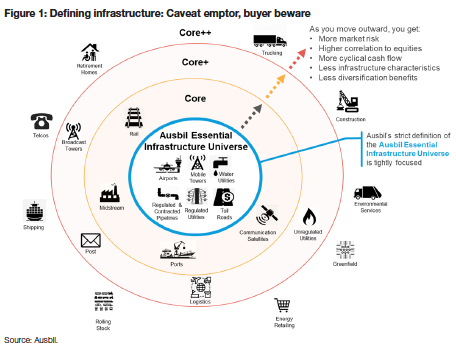
Under Ausbil’s definition of infrastructure, the vast majority of an investment’s cash flow must come from an Essential Infrastructure activity. Essential Infrastructure carries minimal greenfield risk, ideally has no immediate competitors (and low bypass risk), has non-cyclical cash flows, and have negligible or appropriately low demand risk.
What type of return does infrastructure offer investors?
Essential Infrastructure offers a compelling mix of yield, relative stability and long capital growth in the returns it offers investors. On the income or yield side, listed global Essential Infrastructure assets demonstrate strong yield outperformance across most periods when compared to US government bonds also consistently offer a significantly higher yield than global equities, as illustrated in Chart 1.
Chart 1: The relative yield of essential infrastructure compared to 10-yr bonds
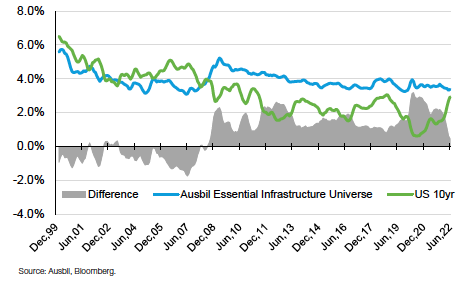
Chart 2: The relative total performance of infrastructure compared to global equities
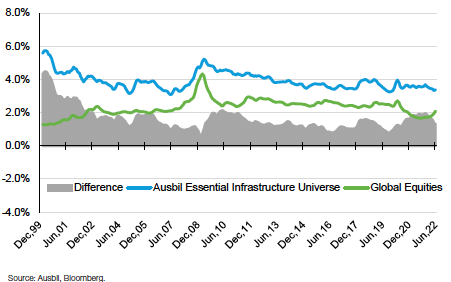
Listed Essential Infrastructure assets have, since 2000, generated an average yield of 3.9% pa (on a rolling basis), compared to the yield generated by global equities (MSCI World) of 2.3% pa, and US 10-year treasuries of 3.2% pa. On average, therefore, the global Essential Infrastructure yield has exceeded global equities by 1.6% pa, and US treasuries by 0.7% pa.
Another important observation relates to the variability in returns. Global Essential Infrastructure has offered more stable yields with lower variability as evidenced by a standard deviation in yields of +/- 0.5%, while similar to the variability in global equity yields of +/- 0.5%, but noticeably lower than the variability in 10-year US treasury yields of +/- 1.3%.
Therefore, the yield of Essential Infrastructure has not only been consistently and notably higher than those of global equities and US bonds, but the yield of the asset class has been more stable, and less volatile.
Is the higher yield in infrastructure riskier than that of global equities?
The unique cash-flow nature of infrastructure is such that equity investors in this sector forego some elements of growth, compared to what is on offer in global equities, in return for a higher relative yield. With Essential Infrastructure, yields are typically backed by large, real assets that hold dominant or allowable monopolistic positions in their respective economies.
For most Essential Infrastructure assets there is little to no competition or substitution, and yields are underpinned by contracts and concessions or regulatory arrangements formulated and agreed with governments and regulators that allow revenue streams to recover operating and capital costs including inflation.
This stability in revenue and earnings can be seen in the EBITDA growth for Essential Infrastructure assets compared to that for global equities, as illustrated in Chart 3.
Chart 3: Infrastructure earnings (EBITDA) growth across the cycle compared to global equities (2000 – 2021)
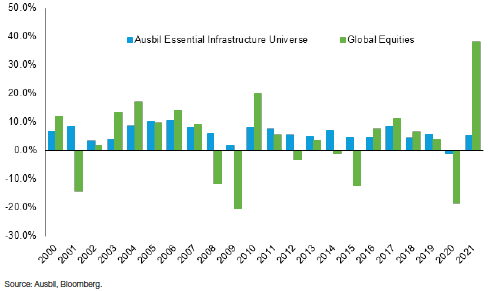
One of the strong themes that can be seen in infrastructure earnings growth is that it is consistently positive through economic cycles. Chart 4 demonstrates this stability compared to the boom-and-bust pattern that can be seen in the earnings growth of general equities. While global equities can enjoy periods of superior earnings growth, a lot of the benefit is given away in market drawdowns or when the earnings cycle goes into major contraction. By contrast, the steady positive earnings growth shown in Essential Infrastructure compounds over the long-term to significantly outperform the far more volatile earnings growth of general equities, as illustrated in Chart 4.
Chart 4: The compounding benefit of infrastructure’s steady EBITDA (earnings) growth outperforms global equities (1999 – 2021)
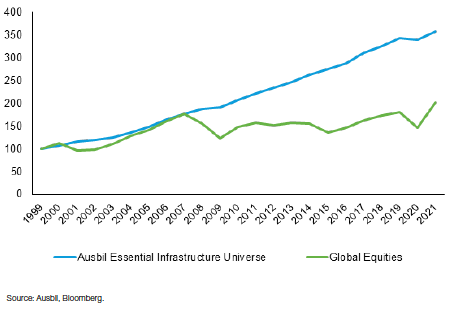
Comparing the key elements of risk between Essential Infrastructure and global equities, we believe infrastructure shows lower risk on average over time, as illustrated in Table 1.
Table 1: Relative risks of Essential Infrastructure compared to global equities
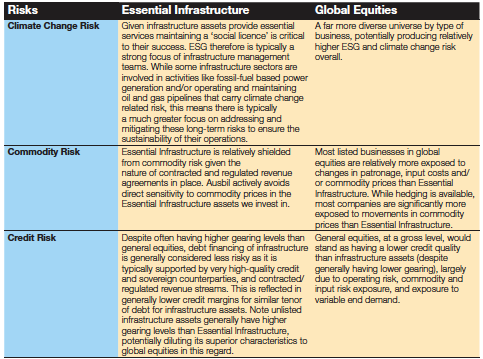
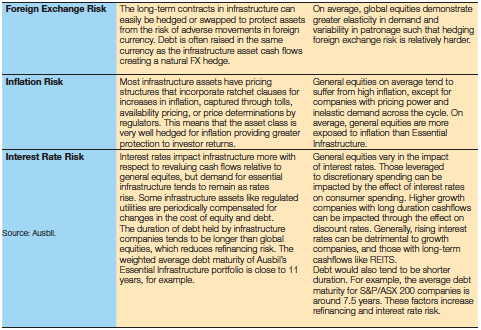
Where are we in the big picture on inflation and interest rates, and how does infrastructure perform in inflationary environments?
Without talking too much on the COVID demand and supply shock, or on the war in Ukraine that precipitated an energy shock, the world economy has witnessed the long-term low in interest rates, and they have begun to rise. Since the early 1990s, rates had been on a long downward cycle. With the onset of COVID in 2020 and emergency monetary policy, these rates fell to near zero in Australia and the US, and negative in Europe – all negative in real terms. As the unprecedented COVID stimulus drove the world back into growth so too did it bring back inflation and interest rate rises, further exacerbated by the invasion of Ukraine.
Essential Infrastructure has historically performed best under a moderate inflation backdrop. This has been the case as inflation translates into healthy cash flow growth through CPI escalators or regulatory uplifts, while not causing significant changes to nominal base yields. Interest rates, globally, are rising, and have risen quickly in 2021 and 2022 with monetary policy normalisation, and the shock to energy prices from the war in Ukraine. However, the economic backdrop of reasonable (albeit slowing) economic growth and elevated inflation is a supportive environment for the asset class.
Persistent inflationary scenarios that test the upper bounds of central bank targets are less beneficial for infrastructure, and any other real assets or equities with duration in their cash flows. However, the effect of higher interest rates and inflation on future cash flows impacts all asset classes.
Importantly, we think that active management can lead to better outcomes when managing inflation impacts on a portfolio. Infrastructure sectors are heterogeneous, and offer the opportunity for active allocation towards sectors that hedge well for inflation, and away from those that offer relatively inferior inflation protection. For example, while the Regulated Utilities sector overall offers strong inflation protection characteristics, the nature and type of economic regulation that applies dictates the level of inflation protection. Similarly, Transportation infrastructure tends to lag in high inflationary environments as these companies typically have long duration in cash flows, and relatively high gearing which makes it more sensitive to increasing bond rates. Active management is a prerequisite to achieving these inflation protection characteristics and exploit any mispricing between sectors.
How would you describe the inflation protection characteristics of Essential Infrastructure?
As described earlier, Infrastructure as an asset class has strong inflation protection characteristics due to the nature of the assets and the regulation and contracts that exist. For investors, this means that infrastructure will offer superior protection to investor returns during high inflation periods compared to other asset classes. Ausbil’s Essential Infrastructure takes that inflation protection characteristics even further due to the narrower definition versus broader approaches to the asset class.
Chart 5 below illustrates the inflation protection characteristics of Ausbil’s Essential Infrastructure Fund. On a weighted average basis, around 95% of the Fund displays strong inflation protection with only a small percentage directly exposed to competitive markets where lesser inflation protection exists.
Breaking this down, ~60% of the Fund has explicit inflation protection – typically where there is a very direct link between actual inflation outcomes and cash flows providing best in class protection to investor returns. Implicit inflation protection represents a further ~27% of the Fund where there is an indirect link between inflation outcomes and cash flows offering strong inflation protection. Fixed-escalation means that there are fixed percentage increases in prices and/or revenues irrespective of inflation outcomes. These are confined to the mobile tower companies and still provide sound inflation protection qualities given their cost structures largely mirror this fixed escalation in revenues. Whether an Essential Infrastructure company provides explicit or implicit inflation protection is determined by its characteristics – the nature of the regulation that might apply or contract/concession that exists. We discuss this in more detail in the next question.
Chart 5: Inflation protection characteristics of Essential Infrastructure
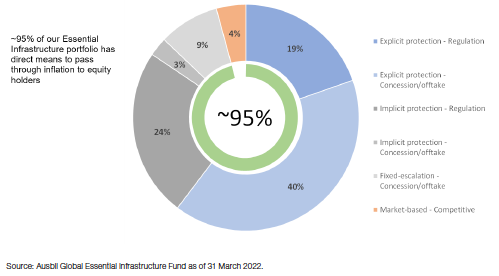
How does inflation impact the key infrastructure sectors from a risk-benefit perspective?
Infrastructure offers significant opportunity for active investors to allocate across sectors and take advantage of the asset classes inherent inflation hedging. Table 2 illustrates the potential benefits and risks of inflation across the key Essential Infrastructure sectors.
Table 2: Where are the inflation risks and benefits across essential infrastructure sectors?
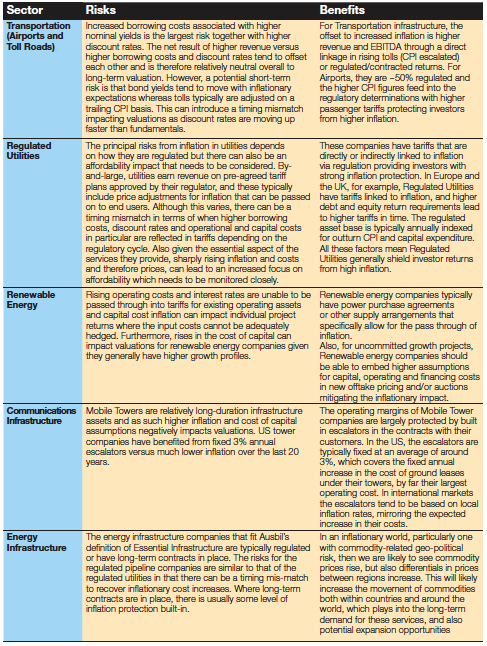
What does all this mean for investors?
For investors seeking superior investment returns, the characteristics of Essential Infrastructure offer relatively higher yield than global equities. In addition, listed Essential Infrastructure offers the potential for attractive capital growth over the long-term underpinned by secular investment opportunities over coming decades relating to, for example, the decarbonisation of economies and the rise of 5G and future mobile technologies. With this superior yield comes less volatility, and relatively lower risk in terms of asset backing and inflation risk compared to global equities. Given these assets are essential to the workings of their respective economies, generally display monopolistic characteristics, and are highly regulated, their overall risk is relatively lower, a prerequisite for those seeking consistent investment yield through an economic cycle.
Invest in stable cash flow assets
Ausbil invests in securities that have assets that are essential for the basic functioning of a society. To find out more, click the 'FOLLOW' button below.
1 topic

